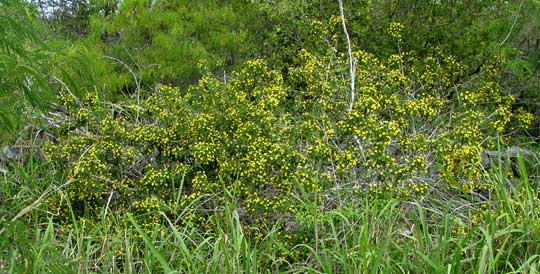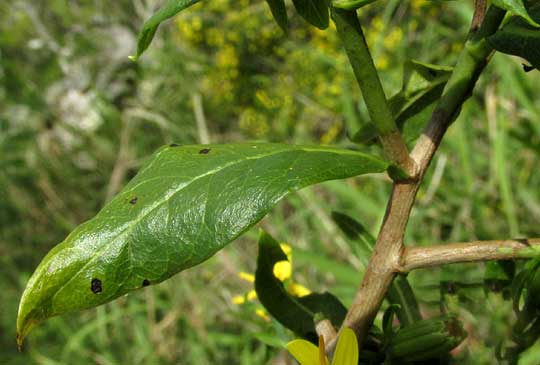Excerpts from Jim Conrad's
Naturalist Newsletter

from the March 1, 2015 Newsletter issued from Río Lagartos, on the Yucatan Peninsula's northern coast (~N21.60°, ~W88.16°), Yucatán state, MÉXICO
TRIXIS
Here and there along the weedy coastal road nowadays a woody, much-branching, head-high bush is at its flowering peak, shown below next to a Maya stone fence with Mesquite in the background:

Up close, it's surprising to see that the flowers are grouped into flower-like flowering heads -- announcing that the bush is a member of the Composite or Sunflower Family, the Asteraceae. The heads look like those of the North's groundsels, genus Senecio, as shown at the top of this page.
Closer up we see that the green, cup-like involucre from which the heads' florets arise is composed of a single series of long, slender, scale-like bracts arranged side by side, which also is like groundsel flowering heads, as seen below:

The North's groundsels are mostly herbaceous, but you might have heard of highland Africa's Tree Senecios. As you "do the botany," you keep all this in mind, and the notion that this might be a bushy groundsel grows and grows. However, notice that the petal-like rays of the flowering head at the picture's left side are turning white and papery as they age. This isn't groundsel-like... The bush's leaves are one per stem node, or alternate, and without lobes or teeth along their margins, which also is unlike groundsels, as shown below:

By now you're starting to doubt that this might be a groundsel or something close to it, so you break open a flowering head looking for more hints as to the bush's identity, and then you see it: Something that in terms of Composite/Sunflower Family taxonomy is as attention-getting as a firecracker going off at your feet. You can see it below:

The individual flowers, or florets, in this bush's flowering heads are not at all typical of those of the Composite/Sunflower Family. Instead of being either distinctly conical disk flowers or flat, strap-shaped ray flowers, all the flowers in our bush's flowering heads are strongly and asymmetrically "two-lipped." In our picture you can see that one of the floret's lips stretches out flatly like a petal, while the other curls beneath itself.
No groundsel has florets anything like this. When you see such bilaterally asymmetrical, two-lipped florets in a Composite/Sunflower Family member, you think of the "tribe" or subdivision known as the Mutisieae. The Mutisieae is a small tribe in a huge family, so recognizing that your unknown plant belongs to it really narrows down the possible identities. Within the Mutisieae, in our part of the world, just noticing that you have a woody shrub with yellowish florets displaying this peculiarity is enough to get you the name.
Our pretty roadside bush is TRIXIS INULA, in some places called the Tropical Threefold, but that "threefold" name alludes to the three-cleft corolla of some other Trixis species and seems so contrived that I can't bear to use it for such a pretty and distinctive plant. I'll go along with Alfred Richardson who in his book Plants of Deep South Texas simply called it Trixis.
Trixis does indeed grow in the scrublands of southern Texas, and all the way south through Mexico's arid regions and the Caribbean islands, south through Central America into northern South America. It's described as inhabiting open, sandy sites, thorn scrub, palm groves, thickets, and roadsides, exactly as we found it.
Trixis is one of several large Composite/Sunflower Family plants Mexicans call Árnica, and most Árnicas are considered medicinal, though their supposed cures vary from place to place. The online Atlas de las Plantas de la Medicina Tradicional Mexicana reports that the whole plant can be brewed to make a hot tea that's good for "rheumatism," motion sickness and "golpes de aire," which translates to something like "air-hits," and refers to the belief that certain pains are caused by build-ups of air in the body, which need to be released. In Michoacán they apply plasters of mashed leaves to sore parts of the body to relieve such pain, and other uses include curing intestinal disorders and venereal diseases.